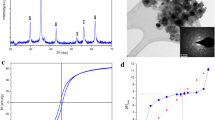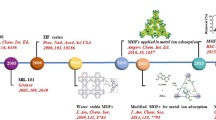Abstract
Adsorption of arsenic (III, V) from aqueous solution onto the synthesized α-Fe2O3/MCM-41 nanocomposite adsorbent, as function of contact time, initial concentration of the solution, temperature, pH, and presence of other anionic species, has been investigated. Characterization of adsorbent was performed via XRD, FT-IR, TGA, TEM, and N2 adsorption–desorption techniques. The synthesized adsorbent belonged to the group of mesoporous materials with the mean pore diameter of 2.37 nm, specific surface area of 507.5 m2 g−1, and total pore volume of 0.571 cm3 g−1. The experimental data were analyzed by Langmuir, Freundlich, and Dubinin-Radushkevich (D–R) adsorption isotherms. Based on Langmuir isotherm, the maximum adsorption capacities at 298 K in the concentration range of 2–200 ppm were 133.3 and 102.1 mg g−1 for As(ш) and As(v), respectively. The adsorption experiments at different contact times indicated that the kinetics of adsorption accurately followed the pseudo-second-order rate equation. Thermodynamics parameters were calculated, and it was found that the adsorption process was spontaneous, exothermic, and favored at lower temperatures. The capability of regeneration and reusability of adsorbent was also examined in alkaline solutions.










Similar content being viewed by others
References
Abbasizadeh, S., Keshtkar, A. R., & Mousavian, M. A. (2014). Sorption of heavy metal ions from aqueous solution by a novel cast PVA/TiO 2 nanohybrid adsorbent functionalized with amine groups. Journal of Industrial and Engineering Chemistry, 20, 1656–1664.
Akin, I., Arslan, G., Tor, A., Cengeloglu, Y., & Ersoz, M. (2011). Removal of arsenate [As (V)] and arsenite [As (III)] from water by SWHR and BW-30 reverse osmosis. Desalination, 281, 88–92.
Azizian, S. (2004). Kinetic models of sorption: a theoretical analysis. Journal of Colloid and Interface Science, 276, 47–52.
Barrett, E. P., Joyner, L. G., & Halenda, P. P. (1951). The determination of pore volume and area distributions in porous substances. I. Computations from nitrogen isotherms. Journal of the American Chemical Society, 73, 373–380.
Beck, J. S., Vartuli, J. C., Roth, W. J., Leonowicz, M. E., Kresge, C. T., Schmitt, K. D., Chu, C. T. W., Olson, D. H., & Sheppard, E. W. (1992). A new family of mesoporous molecular sieves prepared with liquid crystal templates. Journal of the American Chemical Society, 114, 10834–10843.
Boparai, H. K., Joseph, M., & O’carroll, D. M. (2011). Kinetics and thermodynamics of cadmium ion removal by adsorption onto nano zerovalent iron particles. Journal of Hazardous Materials, 186, 458–465.
Brunauer, S., Emmett, P. H., & Teller, E. (1938). Adsorption of gases in multimolecular layers. Journal of the American Chemical Society, 60, 309–319.
Cao, C.-Y., Qu, J., Yan, W.-S., Zhu, J.-F., Wu, Z.-Y., & Song, W.-G. (2012). Low-cost synthesis of flowerlike α-Fe2O3 nanostructures for heavy metal ion removal: adsorption property and mechanism. Langmuir, 28, 4573–4579.
Chen, L., Xin, H., Fang, Y., Zhang, C., Zhang, F., Cao, X., Zhang, C., & Li, X. (2014). Application of metal oxide heterostructures in arsenic removal from contaminated water. Journal of Nanomaterials, 2014, 1–10.
Choong, T. S. Y., Chuah, T. G., Robiah, Y., Koay, F. L. G., & Azni, I. (2007). Arsenic toxicity, health hazards and removal techniques from water: an overview. Desalination, 217, 139–166.
Freundlich, H. M. F. (1906). Over the adsorption in solution. Journal of Physical Chemistry, 57, e470.
Gohari, R. J., Lau, W. J., Matsuura, T., & Ismail, A. F. (2013). Fabrication and characterization of novel PES/Fe-Mn binary oxide UF mixed matrix membrane for adsorptive removal of As (III) from contaminated water solution. Separation and Purification Technology, 118, 64–72.
Hankin, A., Alexander, J. C., & Kelsall, G. H. (2014). Constraints to the flat band potential of hematite photo-electrodes. Physical Chemistry Chemical Physics, 16, 16176–16186.
Huo, Q., Margolese, D. I., & Stucky, G. D. (1996). Surfactant control of phases in the synthesis of mesoporous silica-based materials. Chemistry of Materials, 8, 1147–1160.
Idris, S. A., Harvey, S. R., & Gibson, L. T. (2011). Selective extraction of mercury (II) from water samples using mercapto functionalised-MCM-41 and regeneration of the sorbent using microwave digestion. Journal of Hazardous Materials, 193, 171–176.
Issa, N. B., Rajaković-Ognjanović, V. N., Marinković, A. D., & Rajaković, L. V. (2011). Separation and determination of arsenic species in water by selective exchange and hybrid resins. Analytica Chimica Acta, 706, 191–198.
Karim, M. D. M. (2000). Arsenic in groundwater and health problems in Bangladesh. Water Research, 34, 304–310.
Kiran, I., Akar, T., Ozcan, A. S., Ozcan, A., & Tunali, S. (2006). Biosorption kinetics and isotherm studies of acid red 57 by dried Cephalosporium aphidicola cells from aqueous solutions. Biochemical Engineering Journal, 31, 197–203.
Kresge, C. T., Leonowicz, M. E., Roth, W. J., Vartuli, J. C., & Beck, J. S. (1992). Ordered mesoporous molecular sieves synthesized by a liquid-crystal template mechanism. Nature, 359, 710–712.
Langmuir, I. (1918). The adsorption of gases on plane surfaces of glass, mica and platinum. Journal of the American Chemical Society, 40, 1361–1403.
Liu, C.-H., Chuang, Y.-H., Chen, T.-Y., Tian, Y., Li, H., Wang, M.-K., & Zhang, W. (2015). Mechanism of arsenic adsorption on magnetite nanoparticles from water: thermodynamic and spectroscopic studies. Environmental Science and Technology, 49, 7726–7734.
Mamindy-Pajany, Y., Hurel, C., Marmier, N., & Roméo, M. (2009). Arsenic adsorption onto hematite and goethite. Comptes Rendus Chimie, 12, 876–881.
Mckay, G., & Bino, M. J. (1988). Adsorption of pollutants from wastewater onto activated carbon based on external mass transfer and pore diffusion. Water Research, 22, 279–286.
Mohan, D., & Pittman, C. U. (2007). Arsenic removal from water/wastewater using adsorbents—a critical review. Journal of Hazardous Materials, 142, 1–53.
Mondal, P., Majumder, C. B., & Mohanty, B. (2006). Laboratory based approaches for arsenic remediation from contaminated water: recent developments. Journal of Hazardous Materials, 137, 464–479.
Mondal, P., Balomajumder, C., & Mohanty, B. (2007). A laboratory study for the treatment of arsenic, iron, and manganese bearing ground water using Fe 3+ impregnated activated carbon: effects of shaking time, pH and temperature. Journal of Hazardous Materials, 144, 420–426.
Muniz, G., Fierro, V., Celzard, A., Furdin, G., Gonzalez-Sánchez, G., & Ballinas, M. L. (2009). Synthesis, characterization and performance in arsenic removal of iron-doped activated carbons prepared by impregnation with Fe (III) and Fe (II). Journal of Hazardous Materials, 165, 893–902.
Nikraftar, N., & Ghorbani, F. (2016). Adsorption of As (V) using modified magnetic nanoparticles with ascorbic acid: optimization by response surface methodology. Water, Air, and Soil Pollution, 227, 1–18.
Ociński, D., Jacukowicz-Sobala, I., Raczyk, J., & Kociołek-Balawejder, E. (2014). Evaluation of hybrid polymer containing iron oxides as As (III) and As (V) sorbent for drinking water purification. Reactive and Functional Polymers, 83, 24–32.
Phenrat, T., Marhaba, T. F., & Rachakornkij, M. (2005). A SEM and X-ray study for investigation of solidified/stabilized arsenic-iron hydroxide sludge. Journal of Hazardous Materials, 118, 185–195.
Phenrat, T., Marhaba, T. F., & Rachakornkij, M. (2008). Leaching behaviors of arsenic from arsenic-iron hydroxide sludge during TCLP. Journal of Environmental Engineering, 134, 671–682.
Raji, F., & Pakizeh, M. (2013). Study of Hg (II) species removal from aqueous solution using hybrid ZnCl2-MCM-41 adsorbent. Applied Surface Science, 282, 415–424.
Raji, F., & Pakizeh, M. (2014). Kinetic and thermodynamic studies of Hg (II) adsorption onto MCM-41 modified by ZnCl 2. Applied Surface Science, 301, 568–575.
Rostamizadeh, S., Shadjou, N., Azad, M., & Jalali, N. (2012). (α-Fe2O3)-MCM-41 as a magnetically recoverable nanocatalyst for the synthesis of pyrazolo [4, 3-c] pyridines at room temperature. Catalysis Communications, 26, 218–224.
Salameh, Y., Al-Lagtah, N., Ahmad, M. N. M., Allen, S. J., & Walker, G. M. (2010). Kinetic and thermodynamic investigations on arsenic adsorption onto dolomitic sorbents. Chemical Engineering Journal, 160, 440–446.
Sarkar, S., Greenleaf, J. E., Gupta, A., Ghosh, D., Blaney, L. M., Bandyopadhyay, P., Biswas, R. K., Dutta, A. K., & Sengupta, A. K. (2010). Evolution of community-based arsenic removal systems in remote villages in West Bengal, India: assessment of decade-long operation. Water Research, 44, 5813–5822.
Sawalha, M. F., Peralta-Videa, J. R., Romero-González, J., & Gardea-Torresdey, J. L. (2006). Biosorption of Cd (II), Cr (III), and Cr (VI) by saltbush (Atriplex canescens) biomass: thermodynamic and isotherm studies. Journal of Colloid and Interface Science, 300, 100–104.
Selvam, P., Bhatia, S. K., & Sonwane, C. G. (2001). Recent advances in processing and characterization of periodic mesoporous MCM-41 silicate molecular sieves. Industrial and Engineering Chemistry Research, 40, 3237–3261.
Sing, K. S. W. (1985). Reporting physisorption data for gas/solid systems with special reference to the determination of surface area and porosity (Recommendations 1984). Pure and Applied Chemistry, 57, 603–619.
Singh, T. S., & Pant, K. K. (2004). Equilibrium, kinetics and thermodynamic studies for adsorption of As (III) on activated alumina. Separation and Purification Technology, 36, 139–147.
Srivastava, V. C., Swamy, M. M., Mall, I. D., Prasad, B., & Mishra, I. M. (2006). Adsorptive removal of phenol by bagasse fly ash and activated carbon: equilibrium, kinetics and thermodynamics. Colloids Surf A, 272, 89–104.
Tang, W., Li, Q., Gao, S., & Shang, J. K. (2011). Arsenic (III, V) removal from aqueous solution by ultrafine α-Fe2O3 nanoparticles synthesized from solvent thermal method. Journal of Hazardous Materials, 192, 131–138.
Tuutijärvi, T., Lu, J., Sillanpää, M., & Chen, G. (2009). As (V) adsorption on maghemite nanoparticles. Journal of Hazardous Materials, 166, 1415–1420.
Tuutijärvi, T., Vahala, R., Sillanpää, M., & Chen, G. (2012). Maghemite nanoparticles for As (V) removal: desorption characteristics and adsorbent recovery. Environmental Technology, 33, 1927–1936.
Ursachi, I., Vasile, A., Ianculescu, A., Vasile, E., & Stancu, A. (2011). Ultrasonic-assisted synthesis and magnetic studies of iron oxide/MCM-41 nanocomposite. Materials Chemistry and Physics, 130, 1251–1259.
Ursachi, I., Stancu, A., & Vasile, A. (2012). Magnetic α-Fe2O3/MCM-41 nanocomposites: preparation, characterization, and catalytic activity for methylene blue degradation. Journal of Colloid and Interface Science, 377, 184–190.
Wei, Z., Liang, K., Wu, Y., Zou, Y., Zuo, J., Arriagada, D. C. S., Pan, Z., & Hu, G. (2016). The effect of pH on the adsorption of arsenic (III) and arsenic (V) at the TiO 2 anatase [101] surface. Journal of Colloid and Interface Science, 462, 252–259.
Wu, Y., Jin, Y., Cao, J., Yilihan, P., Wen, Y., & Zhou, J. (2013). Optimizing adsorption of arsenic (III) by NH 2-MCM-41 using response surface methodology. Journal of Industrial and Engineering Chemistry, 20, 2792–2800.
Yadanaparthi, S. K. R., Graybill, D., & Von Wandruszka, R. (2009). Adsorbents for the removal of arsenic, cadmium, and lead from contaminated waters. Journal of Hazardous Materials, 171, 1–15.
Yin, J., Kim, E.-S., Yang, J., & Deng, B. (2012). Fabrication of a novel thin-film nanocomposite (TFN) membrane containing MCM-41 silica nanoparticles (NPs) for water purification. Journal of Membrane Science, 423, 238–246.
Youngran, J., Maohong, F. A. N., Van Leeuwen, J., & Belczyk, J. F. (2007). Effect of competing solutes on arsenic (V) adsorption using iron and aluminum oxides. Journal of Environmental Sciences, 19, 910–919.
Zboril, R., Mashlan, M., & Petridis, D. (2002). Iron (III) oxides from thermal processes synthesis, structural and magnetic properties, Mössbauer spectroscopy characterization, and applications. Chemistry of Materials, 14, 969–982.
Zhou, S., Wang, D., Sun, H., Chen, J., Wu, S., & Na, P. (2014). Synthesis, characterization, and adsorptive properties of magnetic cellulose nanocomposites for arsenic removal. Water, Air, and Soil Pollution, 225, 1–13.
Acknowledgments
The authors gratefully acknowledged the Iran Nanotechnology Initiative Council for the financial supports and Mashhad Water & Wastewater Co. for the arsenic concentration tests.
Author information
Authors and Affiliations
Corresponding author
Rights and permissions
About this article
Cite this article
Boojari, H., Pourafshari Chenar, M. & Pakizeh, M. Experimental Investigation of Arsenic (III, V) Removal from Aqueous Solution Using Synthesized α-Fe2O3/MCM-41 Nanocomposite Adsorbent. Water Air Soil Pollut 227, 290 (2016). https://doi.org/10.1007/s11270-016-2989-6
Received:
Accepted:
Published:
DOI: https://doi.org/10.1007/s11270-016-2989-6




